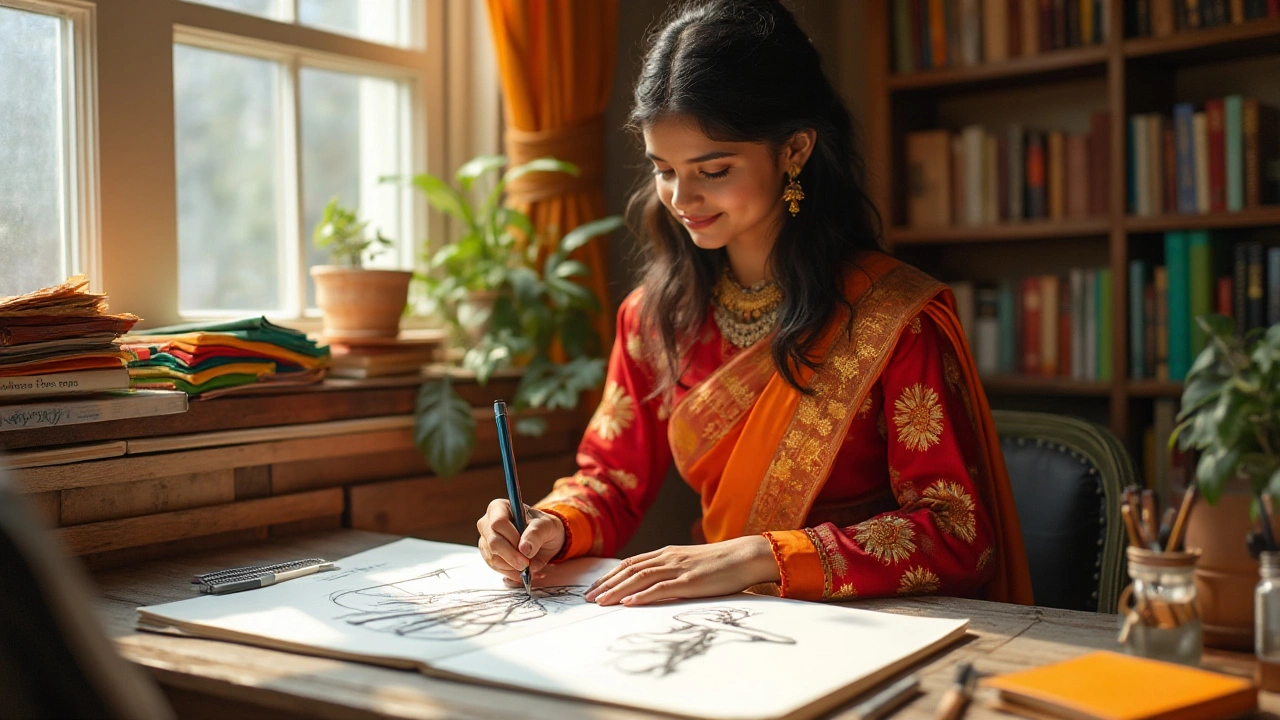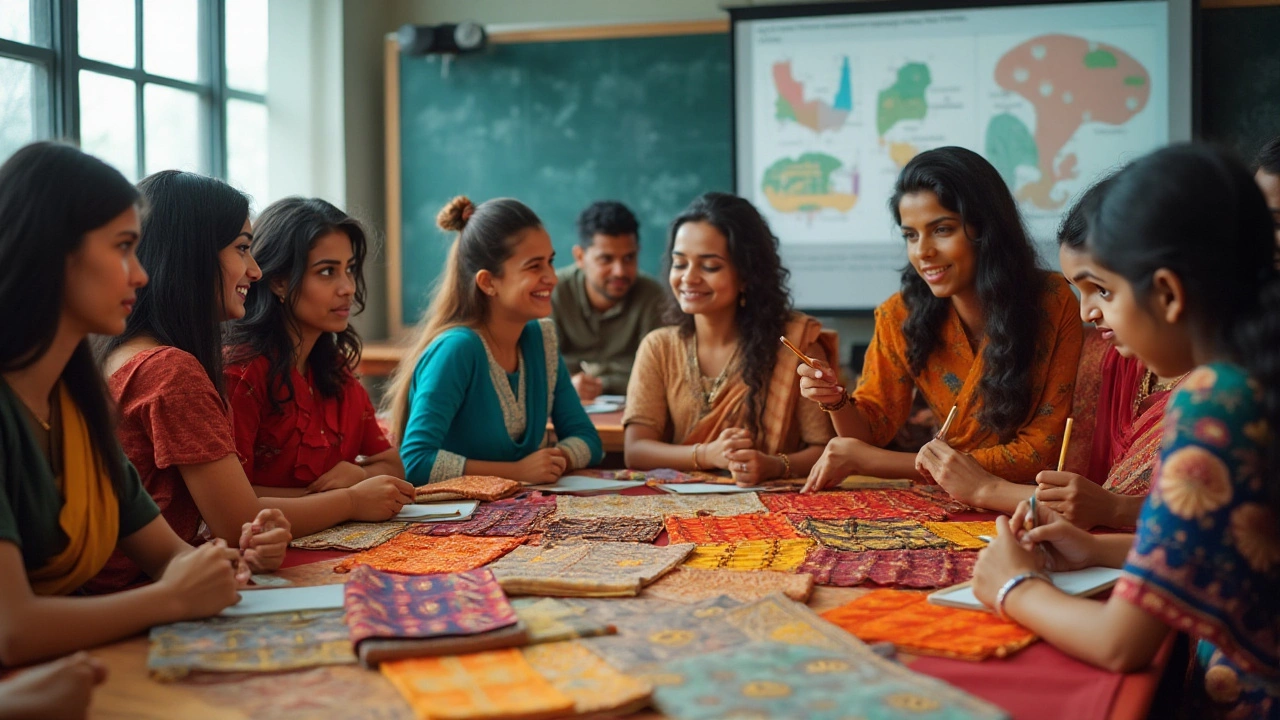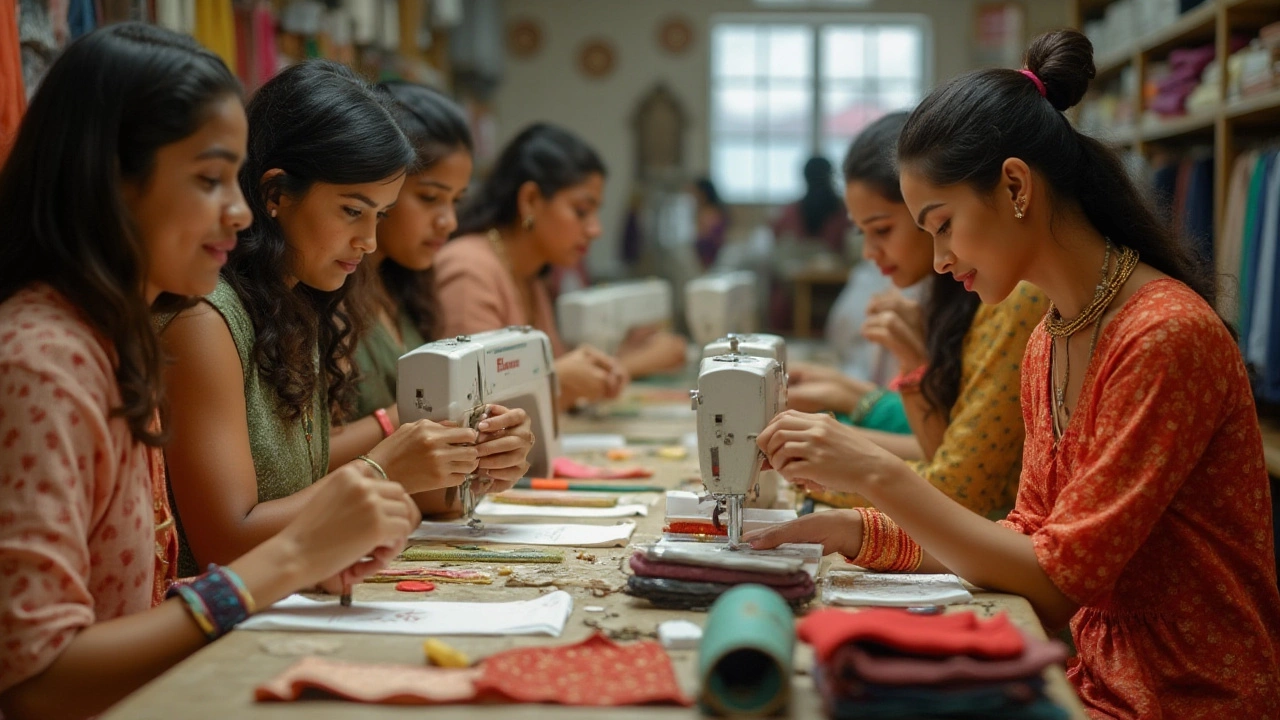
Embarking on a journey to become a fashion designer is like weaving a tapestry of creativity, skill, and persistence. It's a world where imagination takes the lead, and each thread of knowledge adds to the fabric of your future career. For those with a passion for style and an eye for detail, understanding where to begin is crucial.
You'll find that studying to become a fashion designer covers a wide spectrum of topics. From understanding textiles to mastering fashion illustration, the path is as diverse as the styles you'll eventually create. Many aspiring designers often wonder which subjects are pivotal in this creative domain. Delving into the core subjects of fashion design education is the first step towards crafting a career that's both fulfilling and trend-setting.
Whether you're sketching the initial designs in a cozy studio at home or drawing inspiration from bustling city streets, the skills you acquire through structured courses will guide you. Choosing the right path and honing your abilities could open doors to not just the forefront of runway shows, but also into the subtle nuances of everyday fashion.
- Understanding the Core Competencies
- Essential Subjects in Fashion Design
- Skills that Complement Fashion Studies
- Choosing the Right Fashion School
- Tips for Aspiring Fashion Designers
Understanding the Core Competencies
Before diving into the bustling world of fashion design, it's essential to grasp the core competencies that will serve as the building blocks of your career. At the heart of any successful designer's skillset are creativity, keen observation, and innovation. A designer must possess the ability to think outside conventional boundaries, producing unique and captivating creations. Creativity is vital in fashion design, as it encourages experimentation with different styles, textiles, and technologies, forming designs that stand apart yet resonate with people.
Equally important is a strong sense of visualization. Being able to imagine how different elements will work together, and then bringing those ideas to life through sketches and prototypes, is a foundational skill for designers. It isn't only about what looks good on paper; it's about understanding how designs will interact with the human form, expressing personality, culture, and emotion. This imaginative capacity also involves keeping abreast with current fashion trends, as well as anticipating future ones based on social and cultural movements worldwide.
"Fashion should be a form of escapism, and not a form of imprisonment," remarked internationally acclaimed designer Alexander McQueen, reflecting the liberating potential inherent in fashion design.
An adeptness in technical skills is another crucial competency for aspiring designers. Mastery in using fashion design software and understanding garment construction gives designers the flexibility to create with precision and adapt quickly in a fast-paced industry. Programs like Adobe Illustrator or CLO 3D are integral tools for modern fashion creation, helping to translate ideas into tangible representations before they reach the cutting table.
Strong communication skills cannot be overlooked in the realm of fashion. They enable designers to effectively collaborate with various stakeholders, from clients to suppliers, ensuring that their vision is clearly understood and executed. Communicating ideas through clear visual presentations, compelling narratives, and proficient networking allows designers to craft a personal brand and influence industry narratives.
Let's not forget the importance of an entrepreneurial mindset as part of the core competencies. Fashion is as much about business as it is about art. Understanding market demands, managing a budget, promoting a brand, and establishing a sound supply chain are essential for those planning to work independently or launch their own label. For instance, the rise of sustainable fashion is significantly reshaping industry priorities, prompting designers to innovate responsibly and ethically. Statistics suggest that nearly 60% of younger consumers are willing to spend more on sustainable brands, highlighting the importance of adaptability in business strategies to cater to evolving consumer preferences.
Essential Subjects in Fashion Design
In the vibrant universe of fashion, certain subjects act like the DNA of a designer's mindset, instilling both theoretical knowledge and hands-on skills. At the heart of fashion design education is the study of textiles, which forms the backbone of every garment created. Understanding different fabrics, their properties, and uses can set a designer apart as it directly influences the choice of material for specific designs. A designer must appreciate how relevant factors such as fiber composition, weave, and surface treatment play into the draping and texture of clothing.
Equally vital is the skill of fashion illustration, which bridges an idea in the mind to tangible sketches on paper. These drawings are the previsualizations of future collections and play a crucial role in communicating designs to colleagues, manufacturers, and clients. By mastering this subject, aspiring designers can vividly bring their creations to life. A good illustration is not just about talent but also about perspective, proportion, and the ability to show detail, which requires patience and precision.
History of fashion also ranks as an essential component in a designer’s education. It provides a window into past trends and socioeconomic factors affecting them, inspiring contemporary designers with fresh perspectives from previous generations. It is a subject where one learns that styles repeat themselves in cycles, often being modernized or upcycled with a twist to suit new-age sensibilities. This deeper understanding of the past is a tool for innovation today.
Another pivotal subject is pattern making, which requires an analytical mind. It’s essentially the blueprint creation of a garment—from understanding measurements to creating paper outlines that become precise pieces of fabric stitched into clothing. Pattern making is an exercise in accuracy and ingenuity, demanding a grasp of both geometry and creativity.
According to the esteemed fashion icon Diane von Furstenberg, "To be confident and comfortable in what you wear, start by loving what you create."
In addition to these core subjects, computer-aided design (CAD) programs have revolutionized fashion design, allowing designers to digitize their ideas. CAD skills enable designers to efficiently modify sketches, experiment with colors, fabrics, and cuts before physically producing samples. This is a vital skill that can sharply reduce production timelines and costs. Understanding and applying technology in design demonstrates innovation and keeps designers competitive in the industry.
To succeed as a fashion designer, an amalgamation of these subjects is essential. Design thinking, coupled with these specialized skills, creates a foundation for any aspiring fashion designer. Mixing creativity with structured learning and observation enables a clearer pathway to turning one’s fashion dreams into captivating realities. This is especially crucial in a world that's ever-evolving, mirroring the dynamic pace of the fashion industry itself.

Skills That Complement Fashion Studies
In the world of fashion design, success hinges on a blend of creativity and skill. Aspiring designers often focus on core competencies, but understanding which additional skills can propel their careers is equally important. While technical expertise in sewing and pattern-making is essential, other skills, like digital proficiency and trend forecasting, can offer a significant edge. Today's designers are expected to navigate software tools with ease, from Adobe Illustrator to CAD software, expanding their ability to create intricate designs and visual presentations.
An understanding of business is another vital aspect. Designers must balance creative flair with pragmatic decision-making. Knowledge in marketing, branding, and even financial planning can be game-changers, allowing designers to transform ideas into viable fashion businesses. Social media savvy becomes essential, helping designers to connect with their audience, showcase portfolios, and stay updated with global trends.
Connecting with others in the industry is vital. Building strong communication skills, including networking and negotiation, often sets successful designers apart. Engaging effectively with suppliers, clients, and other fashion professionals fosters a collaborative environment that can inspire new ideas and solutions. A quote by designer Stella McCartney encapsulates this well:
"Success in the fashion industry is as much about collaboration as it is about creativity."
Moreover, successful designers possess keen observational skills. They continuously analyze and interpret cultural movements, societal shifts, and consumer behavior. This allows them to forecast trends and adjust their designs accordingly. Reflection and critique are also crucial for growth. Designers must learn to assess their work and respond constructively to feedback, thus enhancing their craft.
Technical drawing skills shouldn't be overlooked either. Powerful illustrations are often the first step towards materializing a concept, playing a key role in communicating visions to the rest of the team. A clear understanding of proportion, fabric behavior, and contemporary styles aids in creating compelling and accurate designs. These skills seamlessly interweave with the theoretical knowledge acquired during fashion courses, creating a balanced and well-rounded skill set.
Lastly, a table showcasing useful software tools might give aspiring designers a glimpse into the digital aids they'll need:
| Software | Purpose |
|---|---|
| Adobe Illustrator | Digital sketching and design |
| CLO 3D | 3D garment visualization |
| TUKAcad | Pattern-making software |
Understanding and developing these complementary skills won't just enhance a designer's portfolio; they ensure a thoughtful integration into the industry, poised to lead and innovate. Whether it's through intricate digital work, strategic business acumen, or effective communication, the ability to adapt and expand one's skill set remains a cornerstone of a prosperous fashion design career.
Choosing the Right Fashion School
Stepping into the glittering world of fashion design often starts with selecting a school that not only nurtures creative flair but also instills a robust technical foundation. When navigating this choice, you should consider several factors to ensure that your education aligns with your aspirations. Start with an assessment of the curriculum. A comprehensive program that covers everything from textiles, pattern making, to fashion photography and business management can offer a well-rounded education. Pay close attention to courses that focus on emerging technologies in fashion, as these are becoming increasingly crucial in today's industry.
Another critical aspect is the faculty. Experienced educators, who have firsthand industry experience, bring invaluable insights and connections that can serve you well beyond the classroom. Moreover, explore if the school offers opportunities for internships or industry collaborations, allowing students to experience the pulse of real-world fashion environments. This practical exposure is as important as classroom learning and often gives graduates a competitive edge.
Evaluating Reputation and Alumni Networks
The prestige and legacy of a fashion school can speak volumes about its contribution to the industry. Schools with a history of producing renowned designers can be a solid testament to the quality of education. Research the career trajectories of alumni — their success stories and the networks they build can open doors for new graduates. Don’t shy away from reaching out to alumni to gather insights about their experiences. They can provide an authentic perspective on the school's environment and how it prepared them for their careers. As the renowned fashion designer Marc Jacobs once said, "A fashion education should be more than about career path; it's about learning to be creative in every sense of the word."
Financial considerations should also be part of your decision-making process. Investigate the tuition fees along with any financial aid options or scholarships the school might offer. Understanding the financial commitment and planning for it can ease the journey ahead. It’s crucial to balance your passion for fashion design with practical considerations.
Considering Location and Campus Amenities
Location can be a significant factor, especially in the fashion industry where being in a fashion hub like New York, Paris, or Milan can provide additional advantages. These cities often host events, shows, and industry gatherings that can augment your learning experience. Proximity to such activities can foster networking opportunities, which are instrumental in establishing a foothold in the fashion world. On-campus amenities are worth investigating too. A well-equipped campus with modern studios, libraries, and exhibit spaces can significantly enhance your educational experience. A vibrant campus often mirrors the creative energy and culture that nurtures budding designers.
If you’re still uncertain, consider visiting the campuses, if possible, or participating in virtual tours. Engaging with current students and faculty during these visits can provide clarity and help you envision whether it's the right fit for you. After all, choosing the right school is not just about the name but about finding an environment that inspires and supports your artistic journey.
Making the Final Decision
Ultimately, the best choice for a fashion school comes down to personal goals and preferences. A school that encourages not just learning but also experimentation and personal growth will likely be the one that sets you on a path to success. With all the information gathered, you can make an informed decision that resonates with your personal vision and career ambitions in fashion design. Remember, your choice will shape the foundation of your skills and professional network. So choose wisely and with care, ensuring that it aligns with your dreams and where you want your fashion story to begin.

Tips for Aspiring Fashion Designers
Embarking on the path to becoming a successful fashion designer requires a mix of passion, commitment, and practical knowledge. While creativity is at the core, understanding the industry's dynamics is crucial. Networking plays a pivotal role; it's not just about making clothes but also about connecting with people who can help advance your career. This means making the most of opportunities to attend events, seminars, and fashion shows to meet established designers and like-minded peers. Remember that persistence and resilience will push you forward even when rejections become part of the journey. Just as fabric must be cut and stitched to form a garment, designers must build their careers step by step, learning and evolving along the way.
Building a portfolio that showcases your best work is essential in demonstrating your skills and vision. This portfolio should reflect your range and creativity, capturing what makes your style unique. Integrating real-world experience into your designs by working on projects or internships can elevate your portfolio. Gain experience by collaborating with established designers or fashion brands, as this exposure can provide invaluable insights into the business. Additionally, immersing yourself in fashion courses that offer practical training and theoretical knowledge is instrumental. Internships can be a stepping stone, giving you a glimpse into the industry's workings and contributing to your personal and professional growth.
Stay informed about the latest trends, technologies, and materials, as the fashion world is ever-evolving. Regularly reading fashion magazines, attending exhibits, and exploring digital fashion platforms can give you fresh ideas and keep you updated on industry shifts. According to The Business of Fashion, "Understanding sustainability and technological innovations in fashion can set designers apart in today's competitive landscape."
Sustainable practices are not just a trend but an imperative—adopting them in your design ethos can give you a competitive edge.In addition to creativity, mastering technology, such as software used for designing and pattern-making, will broaden your capabilities. Compiling a rich resource bank of materials and suppliers is also advantageous for sourcing unique textiles and materials.
Networking isn't just for building your brand; it's about finding mentors who can guide you through your career. Engaging with seasoned professionals gives context and sets benchmarks for your ambitions. Seeking feedback from mentors can often lead to valuable improvements in your work. Social media also offers avenues to connect with global designers and influencers, making the world feel a little smaller and easier to navigate. Participate in online fashion design communities to exchange ideas and collaborate with peers across the globe. Sharing your story and creative process can inspire others and help you remain passionate about the art of fashion design.
Lastly, always nurture your creativity outside the scope of fashion by delving into art, music, and literature, which can serve as a wellspring of inspiration. By surrounding yourself with diverse forms of creativity, you broaden the lens through which you craft your designs. A versatile designer often draws from various influences, making their work distinct and innovative.
Leave a comments